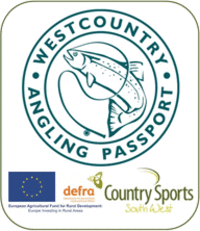The River Parrett extends for a distance of 37 miles, coursing in a general south to north direction from Dorset through Somerset. Its origin can be traced back to the Thorney Mills springs located in the hills near Chedington, approximately 2.5 miles away from the source of the River Axe in Beaminster, which flows in the opposite direction towards the English Channel at Axmouth in Devon. Commencing from its inception, the Parrett meanders northwards, passing through South Perrott and beneath the Salisbury to Exeter railway line, before skirting the western boundaries of North Perrott and Haselbury Plucknett. Subsequently, it traverses fields between Merriott to the west and West Chinnock and Chiselborough to the east. Continuing its course, the river passes beneath the A303 road east of South Petherton, flowing amidst East Lambrook and Bower Hinton to the west of Martock, and then proceeds towards Kingsbury Episcopi, journeying through Thorney and Muchelney, where the remnants of Muchelney Abbey can be found. Eventually, the river reaches Langport, positioned approximately 10 miles north of Chiselborough. Downstream of Thorney Bridge, the riverbanks have undergone elevation to mitigate flooding risks. The Parrett subsequently veers northwest for approximately another 10 miles, cutting through the Somerset Levels and passing by Aller in close proximity to the Aller and Beer Woods and the Aller Hill biological Sites of Special Scientific Interest (SSSI). At the deserted medieval village of Oath, the river's tidal limits are marked by the sluice gate, previously a lock constructed in the late 1830s. This camera was installed and is maintained by the Environment Agency and can be viewed
here All content is available under the
Open Government Licence v3.0.The river then proceeds across Southlake Moor. An important landmark along its course is Burrow Mump, an ancient earthwork presently under the ownership of the National Trust. Continuing onward, the river arrives at Burrowbridge, where the former pumping station building once served as a museum. As it flows northwards, the Parrett passes Langmead and Weston Level SSSI, and continues beyond the land-drainage pumping station at Westonzoyland. Further downstream, the river meanders past the village of Huntworth before passing beneath the M5 motorway at Dunwear. Upon entering Bridgwater, it traverses beneath Somerset and Hamp Bridges and by the historic Bridgwater Castle, which formerly featured a tidal moat, reaching widths of up to 65 feet in certain areas, supplied by water from the river. The stretch from Bridgwater to the sea encompasses an approximate distance of 6 miles. Adjacent to the wharf at Dunball, the River Parrett receives water from the King's Sedgemoor Drain, which enters through a clyce (or clyse), a local term for a sluice. The clyce has been relocated approximately 0.3 miles downstream from its original position, obstructing the entrance to the small harbor adjacent to the wharf. The etymology of the name "Parrett" remains uncertain, although various potential origins have been proposed based on Celtic languages utilized in Wales. Priestley-Evans suggests that "Parrett" may derive from the Welsh term "pared," meaning partition, suggesting that the Welsh inhabitants of Somerset and Devon bestowed this name upon the river as it once demarcated the dividing line between them and the Saxons. Another spelling, "parwydydd," has also been interpreted as partition. Additionally, a Welsh explanation proposes "Peraidd," meaning the sweet or delicious river. An alternative theory rooted in Old English posits a derivation from "Pedair" or "Pedride" stemming from "pedr," signifying four, and "Rit," an Old Cornish term for flow, which would relate to the four flows or streams: the Tone, Yeo, Isle, and Parrett. This interpretation aligns with the explanation presented in Ekwall's 1928 book, "English River Names." Regardless of the precise origin, the name "Parrett" and its variant spellings have been in use since the Anglo-Saxon era, as evidenced by the addition of "-tun" to river names, as exemplified by the local towns of North Petherton and South Petherton. The spellings "Pedred" and "Pedrida" are also referenced in connection with the Parrett. The Oxford Dictionary of British Place Names merely denotes that the name is a "pre-English river-name of obscure origin."



